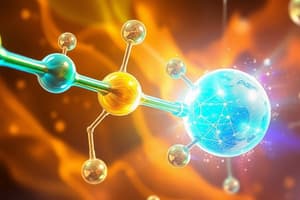Podcast
Questions and Answers
Substances that do not form polar bonds are likely to be:
Substances that do not form polar bonds are likely to be:
- Hydrophobic (correct)
- electrostatic
- hydrophilic
- neither of these options
A molecule with a large number of polar covalent bonds is likely to
A molecule with a large number of polar covalent bonds is likely to
- be highly soluble in water (correct)
- be hydrophobic
- form phosphate bonds
- contain only atoms with low electronegativity
What is the function of proteins inside cells
What is the function of proteins inside cells
- they can serve as structural support
- play a role in ligand recognition and signal transduction
- can reduce bacterial loads through forming barriers on cells
- all of the above (correct)
which of these sugar molecules is NOT a monomer
which of these sugar molecules is NOT a monomer
Hydrolysis is _____ to _____ molecular bonds
Hydrolysis is _____ to _____ molecular bonds
which carbohydrate is NOT found in plants
which carbohydrate is NOT found in plants
where are glycoproteins mainly found?
where are glycoproteins mainly found?
Long polymers are made from single subunits in cells using a ____ reaction, which _____ water
Long polymers are made from single subunits in cells using a ____ reaction, which _____ water
triacyglycerols are
triacyglycerols are
The beginning of a peptide chain is called the ___ terminus whereas the end of the peptide chain is called the ___ terminus
The beginning of a peptide chain is called the ___ terminus whereas the end of the peptide chain is called the ___ terminus
Flashcards are hidden until you start studying



